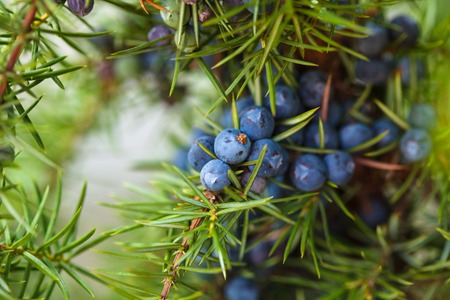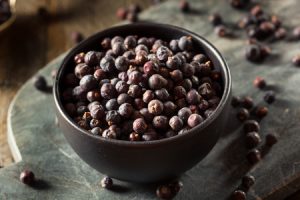
Juniper berries not only bring a distinctive flavour to gin but are widely used in compounding for spices, perfumes and even pharmaceuticals. However, their health benefits are starting to be explored after many years of use in fold medicines. The berry is harvested from shrubby trees, mainly the species Juniperus communis L., family: Cupressaceae, which are found throughout much of the Northern Hemisphere, especially the Mediterranean, and mainly growing in karst or limestone country. The other notable Juniper species are J. oxycedrus L., and J. phoenicea ssp. turbinata. Historically, they have been used from ancient times in folk medicine, exploiting the range of componentry such as vitamin C, polyphenols and tannins and at different stages of maturity or ripeness (Seca and Silva, 2006). The range of conditions treated vary from wound healing, gastric disorders to kidney inflammation (Honda et al., 1996).

The Essential Oil From Berries
The essential oil can serve as an antibacterial and antifungal agent (Pepeljnjak et al., 2005) and has been comprehensively described (Chatzopoulou and Katsiotis, 1993; Adams, 1998; Chatzopoulou et al., 2002). The oil level in the berry ranges from 0.5 to 2.5% v/w. The unripe green berries and the ripe blue berries mainly contain a mixture of mono- and sesquiterpene hydrocarbons.
The main compounds are terpenes such as the α- and β- pinenes, δ-3-carene, sabinene, D-germacrene, β-phellandrene, thujone, myrcene and limonene to name a few (Angioni et al., 2003). There are also sequiterpene hydrocarbons caryophyllene, cadimene and elemene. The oxygenated terpenes which occur in minor quantities are probably responsible for the sophisticated juniper aroma.
There is a component probably responsible for the diuretic properties which is due to the presence of high levels of the terpene alcohol, terpinen-4-ol which is found in a number of other plant essential oils. It is apparent that essential oils obtained from the same species such as J. oxycedrus varies with different regions of growth (Adams, 1998; Guerra Hernandez et al., 1987; Milos and Radonic, 2000).
Flavonoids and biflavonoids were identified using HPLC-DAD and a combination of HPLC-ESI-MS (Innocenti et al., 2007). The flavonoid content ranges from 1.5 to 3.8 mg/g pulp and the biflavanoids from 0.14 to 1.38 mg/g pulp. Notably, 16 compounds were identified including isoscutellarein, 8-hydroxyluteolin and 6 bioflavonoids including amentoflavone.
The berries are often prepared as alcoholic extracts and infusions depending on which component is most desirable. The antioxidant properties of the essential oil have been compared with other sources and α-tocopherol as a control at a level of 500 µg/ml using an aldehyde-carboxylic acid assay (Wei and Shibamoto, 2007).
Recent studies on the hypoglycaemic and diabetic properties of the berries from J. oxycedrus have been tested with some positive results in a streptozotocin-induced diabetic rat model (Orhan et al., 2012). It remains to conduct human intervention studies.
References
Adams, R. P. (1998) The leaf essential oils and chemotaxonomy of Juniperus sect. Juniperus. Biochem. Syst. Ecol. 26,pp. 637-645.
Angioni, A., Barra, A., Russo, M.T., Coroneo, V., Dessi, S., Cabras, P. (2003) Chemical Composition of the Essential Oils of Juniperus from Ripe and Unripe Berries and Leaves and Their Antimicrobial Activity. J. Agric. Food Chem., 51 (10), pp 3073–3078 DOI: 10.1021/jf026203j
Chatzopoulou, P. S.; de Haan, A.; Katsiotis, S. T. (2002) Investigation on the Supercritical CO2 extraction of the volatile constituents from Juniperus communis obtained under different treatments of the “berries” (Cones). Planta Med. 68, pp. 827-831.
Chatzopoulou, P. S.; Katsiotis, S. T. (1993) Study of the essential oil from Juniperus communis berries growing wild in Greece. Planta Medica. 59(6), pp. 554-556.
Hänsel, R., Sticher, O., Steinegger, E. (1999) In: Pharmakognosie – Phytopharmazie, 6th ed., Springer Verlag, Berlin pp. 860–861.
Honda, G., Yesilada, E., Tabata, M., Sezik, E., Fujita, T., Takeda, Y., Takaishi, Y., Tanaka, T., (1996) Traditional medicine in Turkey. VI. Folk medicine in West Anatolia: Afyon, Kutahya, Denizli, Mūgla, Aydın provinces. J. Ethnopharmacol., 53, pp. 75–87.
Innocenti, M., Michelozzi, M., Giaccherini, C., Ieri, F., Vincieri, F.F., Mulinacci, N. (2007) Flavonoids and Biflavonoids in Tuscan Berries of Juniperus communis L.: Detection and Quantitation by HPLC/DAD/ESI/MS. J. Agric. Food Chem., 55 (16), pp 6596–6602 DOI: 10.1021/jf070257h
Pepeljnjak, S., Kosalec, I., Kalodera, Z., Blazevic, N., (2005) Antimicrobial activity of juniper berry essential oil (Juniperus communis L., Cupressaceae). Acta Pharm. 55, pp. 417–422.
Seca, A.M.L., Silva, A.M.S., (2006) The chemical composition of the Juniperus genus (1970–2004). In: Govil, J.N., Singh V.K. (Eds.), Recent Progress in Medicinal Plants, Vol. 16 – Phytomedicines. Studium Press LLC, Houston, pp. 399–520.
Wei, A., Shibamoto, T. (2007) Antioxidant activities and volatile constituents of various essential oils. J. Agric. Food Chem., 55 pp. 1737-1742
Did you read about the project to save our Juniper Berries ? Thank Richard Deverell for a start, Director of Royal Botanic Gardens in Kew. I noticed in the Metro he had mentioned ‘2016 has been a fantastic year for the UK National Tree Seed Project and I’m delighted to hear that we’ve fully collected and conserved our native juniper species. This project is a huge undertaking, but once complete it will provide a fundamental collection of our iconic British trees, helping Kew to lead the way in tackling the many threats facing the UK’s stunning woodlands.’ I guess Gin really is saved. By the way I like your wiki like article on gin but there is so much you can talk about. Happy to set some posts up for you as I’m fascinated by it. Are you aiming to sell some from your web-site ?
Read more: http://metro.co.uk/2017/01/31/no-need-to-panic-the-gin-shortage-has-been-averted-6417007/#ixzz4YfbXG7mb